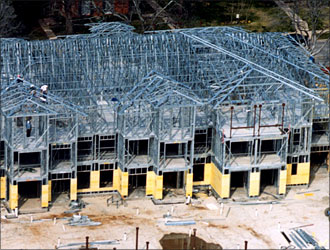 |
| Cold-Formed Steel Frame |
Strength. Steel has the highest strength-- to-- weight ratio of any building material. Moreover, the strength of cold-formed steel also provides architects with greater flexibility, allowing designs that incorporate longer spans and other architectural features.
Durability. Steel is inorganic, and thus impervious to termites, rot and mold. A protective layer of zinc and other metallic coating steel provides long-term durability that research demonstrates can last hundreds of years without any deterioration.
Stability. Due to its consistent chemistry, steel behaves in a highly predicable manner when subjected to the structural loads and stresses imposed by high wind and seismic forces. Because steel cannot absorb moisture, its use also eliminates most of the expansion and contraction of construction materials that produces cracks, warps, and other defects in both internal and external finishes.
Non-combustibility. Steel does not burn and will not contribute to the spread or intensity of a fire. Because of this, cold-formed steel projects can easily be designed to meet code fire rating requirements. Non-combustible structures, like those built with cold-formed steel framing, have a better loss history than combustible wood framing. This often translates into lower costs and broader coverages for many types of construction insurance.
Sustainability. Steel is the only building material that is infinitely recyclable. As a recognized green building material, cold-formed steel framing projects can earn credits for green building ratings such as LEED and similar programs.
Cost-effectiveness. Cold-formed steel offers cost savings on a number of fronts. By helping to minimize fi re risk, the use of cold-formed steel results in lower insurance costs for builders and owners. Additionally, panelized cold-formed steel construction methods produce shorter construction cycles, allowing builders to complete steel-framed projects months faster than with other framing materials. Finally, framing with cold-formed steel generates far less material waste than traditional wood framing
SFIA and other organizations continue to work to encourage the development of industry standards, building codes and construction methods that maximize these unique qualities of cold-formed steel framing.
SFIA and other organizations continue to work to encourage the development of industry standards, building codes and construction methods that maximize these unique qualities of cold-formed steel framing.


I like the benefits of the strength and durability, but I really love how a steel framed building is non-combustible. It seems like you could have a lot more floor space with the use of steel trusses and girders. I would imagine that a lot of warehouses and other types of industrial buildings could benefit from using steel in their construction. http://rijak.com.au/our-services/
ReplyDelete